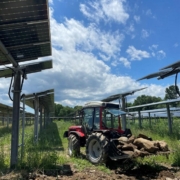Expanding Agrivoltaics in Massachusetts
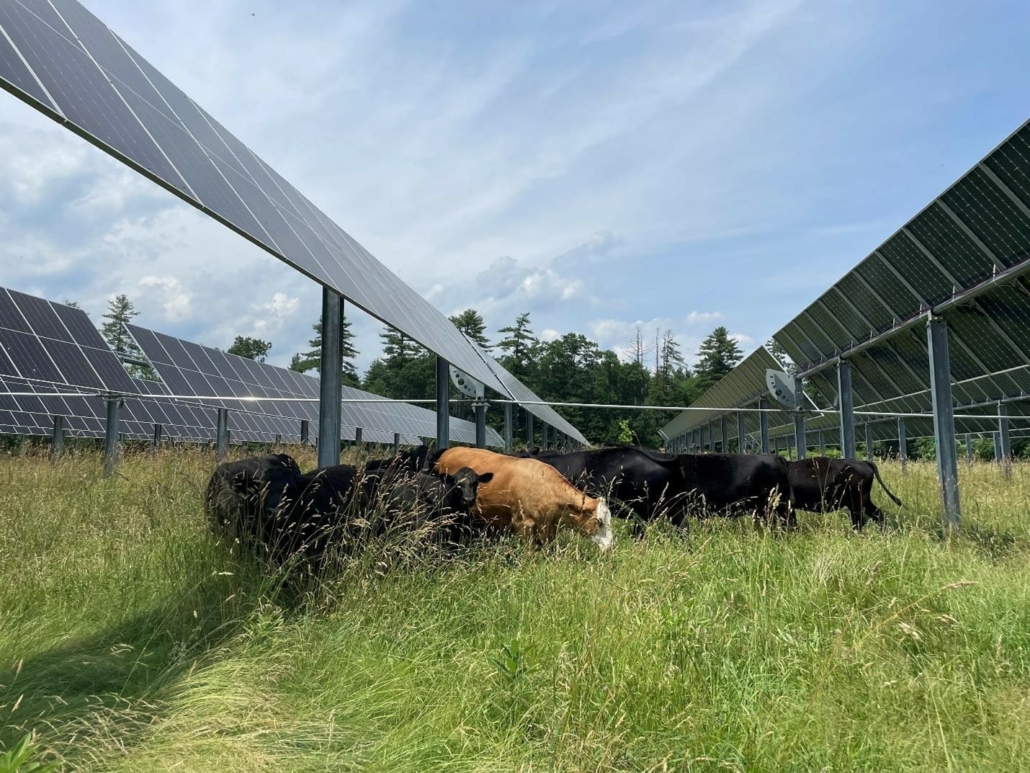
For several years, NCAT has been highlighting the benefits of agrivoltaics through the AgriSolar Clearinghouse project. And just as there are significant benefits to agrivoltaics, there are also barriers that keep more sites from being developed across the country, such as extra costs for site design, reduced energy production per acre, regulatory issues, and community pushback. In the current environment, it can take a passionate, mission-driven company to lead the way in changing how solar is integrated into agricultural systems. BlueWave is one such company.
BlueWave, a Boston-based solar development company, focuses on agrivoltaic solar projects, helping farmers design and integrate solar energy production on their farmland. One of the most prolific agrivoltaic developers in the country, BlueWave has recently added five more of these sites to their project portfolio, which totals over 91 acres and produces over 19 megawatts (MW) of electricity—enough to power more than 2,500 homes.
BlueWave’s latest series of installations began in 2023 and will be completed this year in four separate towns across Massachusetts. These systems were designed for adaptive dual-use purposes, meaning that a variety of agricultural enterprises can take place under the panels. Collectively, these solar installations represent many major agrivoltaic practices, including vegetable production, hay making, and grazing of sheep and cattle. Also, the forage blends used on the grazing sites include plants that are beneficial for pollinators.
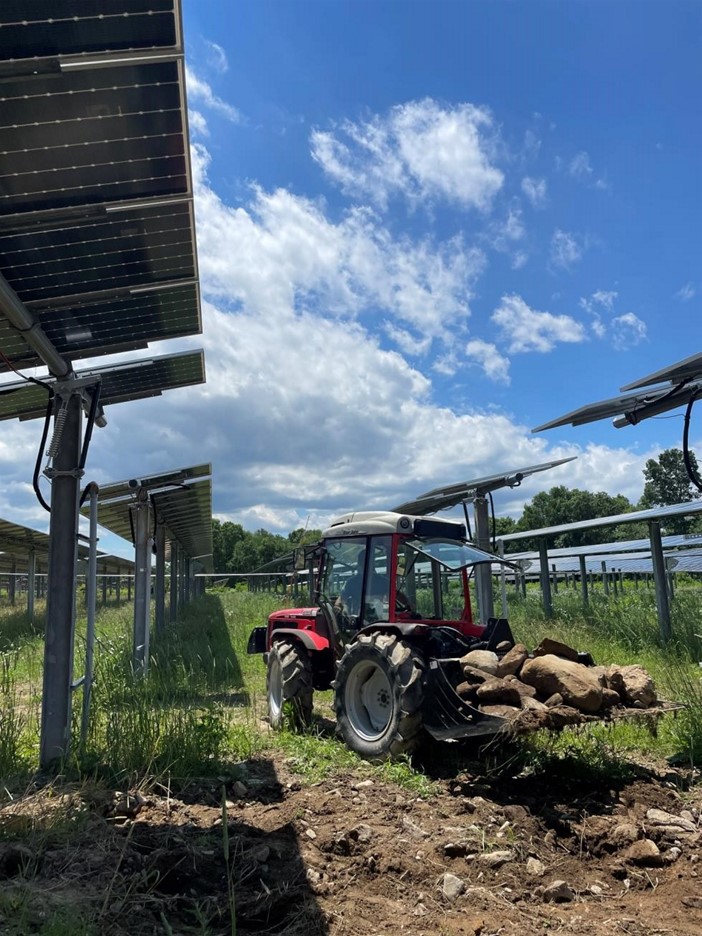
(Caption: The increased height of the panels at this Dighton location allows the farmer to access the land with agricultural equipment. Photo: BlueWave)
One project in Dighton, Massachusetts, encompasses 21 fenced acres with 3.6 MW of installed solar panels that will produce an estimated 5,660 megawatt-hours of energy annually. Battery storage will contribute to the resilience of the electric grid by allowing the installation to provide clean energy to the grid when the sun isn’t shining. The panels here are raised 10 feet off the ground with 25 feet of space between the rows of panel post supports. This spacing will allow for agriculture equipment operation under the panels. BlueWave will be managing this site for the 2024 season, planting cover crops to improve soil health and fertility in preparation for vegetable production on the site. A small section of the land will be used to grow vegetables this year, though the final agricultural use will be determined by the farmer and will be adaptable over the years.
An hour away in the town of Douglas, a very similar solar installation will soon be completed and will be managed by a local farmer. Just over 20 acres was fenced to house 3.4 MW of power production. These panels are also raised and spaced to allow the farmer to maintain and harvest the hay fields below the panels.
A third, slightly smaller BlueWave agrivoltaic site was completed in Haverhill, a town in the far northeastern part of the state. Almost 15 acres were fenced in here with just over 2 MW of solar installed. Again, the panels were raised high enough to allow for grazing or tractor work on the fields
below the panels. A combination of vegetable production and livestock grazing by local farmers is the most likely use for this location.
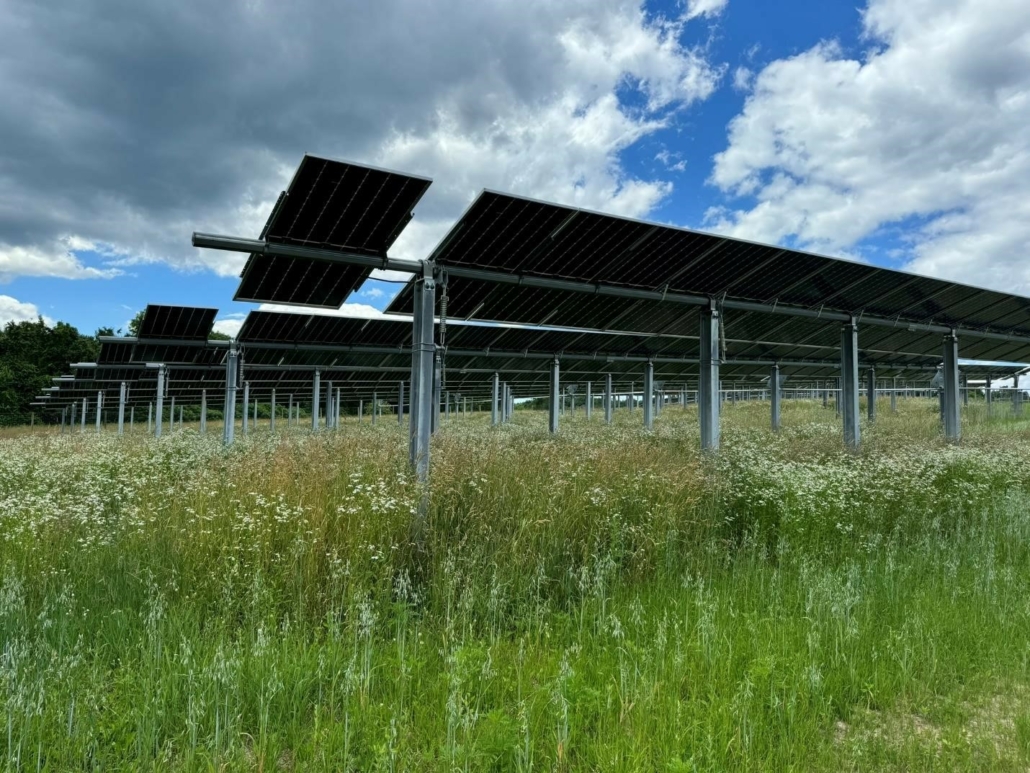
(Caption: This site in Haverhill, Massachusetts, stands ready for grazing and vegetable production by local farmers. Photo: BlueWave)
On the other side of the state, a 2.4-MW system covering almost 12 acres was developed near the town of Palmer. This system, like the others, is designed for tractor work and large livestock grazing. The site will continue to be used by the landowner, Burgundy Brook Farm, for making hay and to graze cattle. As with the other sites that will see the use of farming equipment under the panels, the solar arrays are elevated, and the support posts are spaced to accommodate equipment and to allow enough sunlight to grow crops and forages under the panels.
A fifth BlueWave installation, also in Palmer, has a more conventional design with the panels closer to the ground and the panel rows closer together. But even here, the plan is for sheep grazing to manage the vegetation under the panels. Solar grazing like this can benefit farmers looking for land to graze their sheep. It can be less costly for the solar site management than hiring a land-management company or landscaper to do the job. And the generous amount of shade provided by the panels has multiple benefits for the sheep herd and the forage being grown. (See the recent ATTRA blog post “Throw Some Shade: Protecting Livestock from Heat Stress.”)
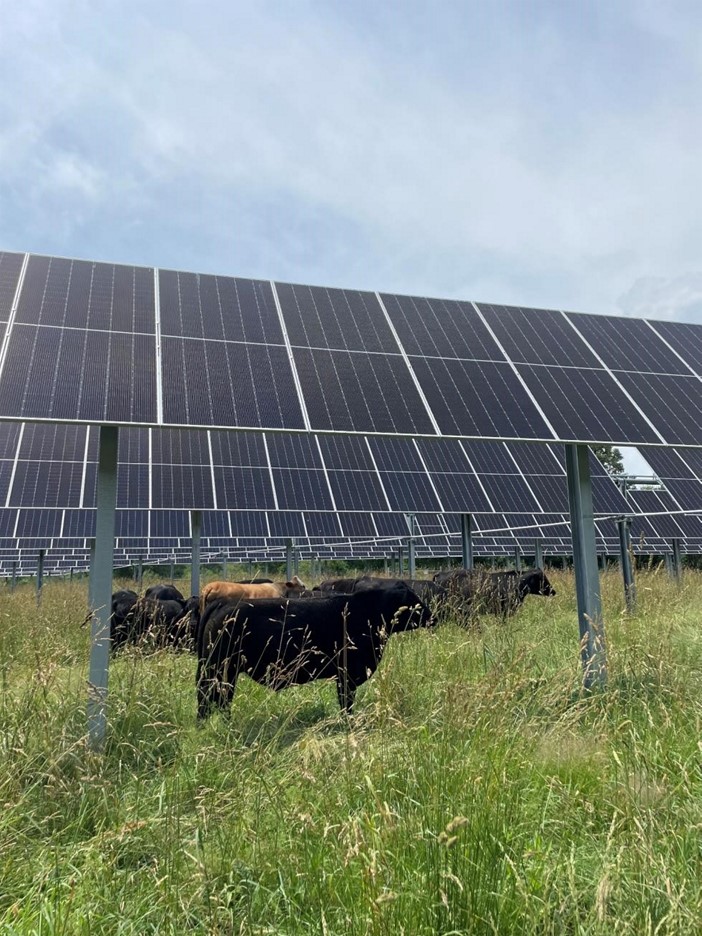
(Caption: Burgundy Brook Farm owns the land at this site in Palmer and will continue to graze cattle and make hay here. Photo: BlueWave)
In a further commitment to support agricultural production, BlueWave provided specialized farm equipment for use at several of these sites. For the site in Dighton, BlueWave has purchased a Carraro 80-hp tractor, a 3-shank chisel plow, a rotary harrow and seeder, a flail mower, and a 3-point to skid-steer adapter plus buckets. They anticipate purchasing an additional cultivating tractor, plastic mulch layer and water wheel transplanter for use on this site. Additionally, BlueWave purchased a John Deere 5425 and a Kuhn baler for Burgundy Brook Farm to use in their hay and grazing operation at the site in Palmer.
Agrivoltaics can help mitigate many of the challenging issues associated with the intense expansion of utility- scale solar development happening across the country. It can keep land in agricultural production while simultaneously producing valuable solar energy for the grid. The shade provided by the solar arrays can help retain soil moisture and improve the growth of many types of crops and forages with reduced irrigation. The shade also reduces heat stress and improves herd health when the land is used for grazing. The financial benefits for the farmer can help keep high-value land as farmland and facilitate the transfer of that land to the next generation. BlueWave understands these possibilities and is creating a space for them with on-the-ground agrivoltaic installations in Massachusetts.

